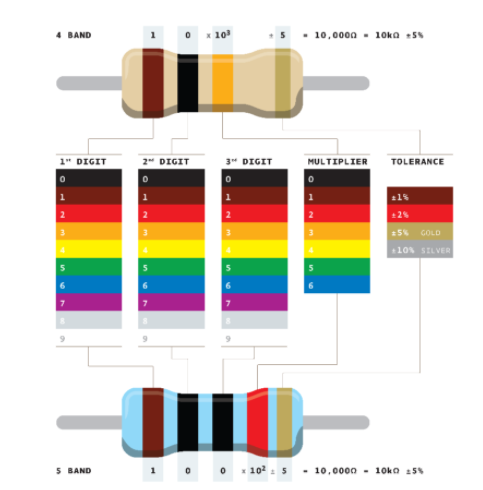
The colour code of a resistor is brown, black and brown. Then the value of resistance is
A. \[10{\text{ }}\Omega \]
B. \[100{\text{ m}}\Omega \]
C. \[0.1{\text{ k}}\Omega \]
D. \[1000{\text{ }}\Omega \]
Answer
179.7k+ views
Hint Usually, all the leaded resistors with power ratings up to one watt are very tiny and it is very difficult to print the resistance values on them. That’s why bands of different colours are printed on the resistors to identify its value of resistance. These bands of colours are called resistor colour code.
In the figure given below the codes for different colours is given. For 3 colour bands, the resistance is given by $R = \left( {{\text{1st colour digit}}} \right)\left( {{\text{2nd colour digit}}} \right)\left( {{\text{3rd colour multiplier}}} \right)\Omega $ .
Complete step by step answer
A resistor is an electrical component which when connected in a circuit resists the flow of current through it.
Now let us discuss how colour code is important for the resistors.
Usually, all the leaded resistors with power ratings up to one watt are very tiny and it is very difficult to print the resistance values on them. That’s why bands of different colours are printed on the resistors to identify its value of resistance. These bands of colours are called resistor colour code.
In the figure given below the codes for different colours is given.

As given in the question that the colour code of the resistor is brown, black and brown and for 3 colour bands, the resistance is given by $R = \left( {{\text{1st colour digit}}} \right)\left( {{\text{2nd colour digit}}} \right)\left( {{\text{3rd colour multiplier}}} \right)\Omega $. The multiplier is the $10$ raised to the power of the digit of that colour.
From the figure we can say that the colour code brown is $1$ and that for black is $0$. Then for the resistor with colour code brown, black and brown will be $10 \times {10^1}{\text{ }}\Omega = 0.1{\text{ k}}\Omega $.
Hence, option C is correct.
Note To read the resistor colour code, hold the resistor in such a way that the tolerance colour band is on the right most side of the rest of the colour bands. The tolerance band is normally silver or gold in colour. Now, note the colours from left to right side. The band which is just before the tolerance band is called the multiplier band. Now, use the table of colour code to find the value of resistance.
The number of colour bands usually varies from three to six in a resistor.
In the figure given below the codes for different colours is given. For 3 colour bands, the resistance is given by $R = \left( {{\text{1st colour digit}}} \right)\left( {{\text{2nd colour digit}}} \right)\left( {{\text{3rd colour multiplier}}} \right)\Omega $ .
Complete step by step answer
A resistor is an electrical component which when connected in a circuit resists the flow of current through it.
Now let us discuss how colour code is important for the resistors.
Usually, all the leaded resistors with power ratings up to one watt are very tiny and it is very difficult to print the resistance values on them. That’s why bands of different colours are printed on the resistors to identify its value of resistance. These bands of colours are called resistor colour code.
In the figure given below the codes for different colours is given.

As given in the question that the colour code of the resistor is brown, black and brown and for 3 colour bands, the resistance is given by $R = \left( {{\text{1st colour digit}}} \right)\left( {{\text{2nd colour digit}}} \right)\left( {{\text{3rd colour multiplier}}} \right)\Omega $. The multiplier is the $10$ raised to the power of the digit of that colour.
From the figure we can say that the colour code brown is $1$ and that for black is $0$. Then for the resistor with colour code brown, black and brown will be $10 \times {10^1}{\text{ }}\Omega = 0.1{\text{ k}}\Omega $.
Hence, option C is correct.
Note To read the resistor colour code, hold the resistor in such a way that the tolerance colour band is on the right most side of the rest of the colour bands. The tolerance band is normally silver or gold in colour. Now, note the colours from left to right side. The band which is just before the tolerance band is called the multiplier band. Now, use the table of colour code to find the value of resistance.
The number of colour bands usually varies from three to six in a resistor.
Recently Updated Pages
Uniform Acceleration - Definition, Equation, Examples, and FAQs

JEE Main 2025-26 Mock Test: Dual Nature of Matter & Radiation

JEE Main Mock Test 2025-26: Dual Nature of Matter & Radiation

Young's Double Slit Experiment Step by Step Derivation

JEE Atomic Structure and Chemical Bonding important Concepts and Tips

JEE Amino Acids and Peptides Important Concepts and Tips for Exam Preparation

Trending doubts
JEE Main 2025 Session 2: Application Form (Out), Exam Dates (Released), Eligibility, & More

JEE Main 2025: Derivation of Equation of Trajectory in Physics

Displacement-Time Graph and Velocity-Time Graph for JEE

Electric field due to uniformly charged sphere class 12 physics JEE_Main

Atomic Structure - Electrons, Protons, Neutrons and Atomic Models

Learn About Angle Of Deviation In Prism: JEE Main Physics 2025

Other Pages
JEE Advanced Marks vs Ranks 2025: Understanding Category-wise Qualifying Marks and Previous Year Cut-offs

What is Hybridisation in Chemistry?

JEE Main 2025: Conversion of Galvanometer Into Ammeter And Voltmeter in Physics

JEE Advanced Weightage 2025 Chapter-Wise for Physics, Maths and Chemistry

Wheatstone Bridge for JEE Main Physics 2025

Electric Field Due to Uniformly Charged Ring for JEE Main 2025 - Formula and Derivation




